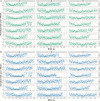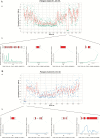Transfer of a starch phenotype from wild wheat to bread wheat by deletion of a locus controlling B-type starch granule content
- PMID: 29099990
- PMCID: PMC5853964
- DOI: 10.1093/jxb/erx349
Transfer of a starch phenotype from wild wheat to bread wheat by deletion of a locus controlling B-type starch granule content
Abstract
Our previous genetic analysis of a tetraploid wild wheat species, Aegilops peregrina, predicted that a single gene per haploid genome, Bgc-1, controls B-type starch granule content in the grain. To test whether bread wheat (Triticum aestivum L.) has orthologous Bgc-1 loci, we screened a population of γ-irradiated bread wheat cv. Paragon for deletions of the group 4 chromosomes spanning Bgc-1. Suitable deletions, each encompassing ~600-700 genes, were discovered for chromosomes 4A and 4D. These two deletions are predicted to have 240 homoeologous genes in common. In contrast to single deletion mutant plants, double deletion mutants were found to lack B-type starch granules. The B-less grains had normal A-type starch granule morphology, normal overall starch content, and normal grain weight. In addition to variation in starch granule size distribution, the B-less wheat grains differed from controls in grain hardness, starch swelling power, and amylose content. We believe that these B-less wheat plants are the only Triticeae cereals available that combine substantial alterations in starch granule size distribution with minimal impact on starch content.
Keywords: B-type starch granules; Breeding; Triticeae; deletion mutant; grain hardness; granule size distribution; starch granule initiation; starch swelling power; wheat grain.
© The Author 2017. Published by Oxford University Press on behalf of the Society for Experimental Biology.
Figures



References
-
- Ao Z, Jane J-L. 2007. Characterization and modeling of the A- and B-granule starches of wheat, triticale, and barley. Carbohydrate Polymers 67, 46–55.
-
- Bathgate GN, Clapperton JF, Palmer GH. 1974. The significance of small starch granules. In: European Brewery Convention, Proceedings of the 14th Congress, Salzberg Elsevier Scientific Publishing, 183–196.
-
- Bechtel DB, Wilson JD. 2003. Amyloplast formation and starch granule development in hard red winter wheat. Cereal Chemistry 80, 175–183.
-
- Bechtel DB, Zayas I, Kaleikau L, Pomeranz Y. 1990. Size-distribution of wheat starch granules during endosperm development. Cereal Chemistry 67, 57–63.
MeSH terms
Substances
LinkOut - more resources
Full Text Sources
Other Literature Sources

